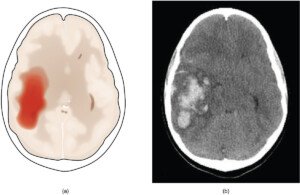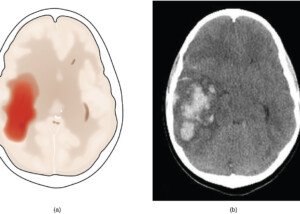
An MRI can easily detect a brain aneurysm (aka “time bomb”), so why isn’t the MRI a standard screening tool for this often fatal condition?
How often have you heard of a famous person, celebrity or media personality who died from a ruptured brain aneurysm?
It’s rare, but when it happens, it’s shocking. It also makes you think, Gee, had they known they had an aneurysm in the brain, it could have been treated.
“Magnetic resonance angiography (a type of MRI) can be used to search for un-ruptured brain aneurysms,” says Resham Mendi, MD, a renowned expert in the field of medical imaging, and the medical director of Bright Light Medical Imaging.
“Some studies have shown that one to six percent of the population have an aneurysm,” continues Dr. Mendi.
“Depending on the size, some are at higher risk of rupture than others.”
Notable People Who Died from Ruptured Cerebral Aneurysm

Brain aneurysm rupture. Shutterstock/OpenStax College
• Guy Williams (John Robinson on “Lost in Space”)
• Laura Branigan (made “Gloria” a hit song in the early ‘80s)
• Lisa Colagrossi (TV news anchor/reporter)
There’ve been many more over the years. It’s not that famous people are more important than “regular” people, but let’s face it:
When a media personality dies from a ruptured brain aneurysm that nobody knew existed prior, it’s quite a shocker.
Aneurysms can be managed with clipping, coiling or serial observation. Otherwise, the risk is that over time they grow so big that they burst, causing massive bleeding in the brain known as a hemorrhagic stroke.
- One-third of victims will die.
- One-third will be left with brain damage.
- Only one-third will recover well.
When people go to emergency rooms with symptoms suspicious for a leaking or ruptured aneurysm, they are given a CT scan (radiation), because this is far faster than an MRI (no radiation).
But imagine the lives, over the years, that would have been saved had MRI screenings for cerebral aneurysms been routine for apparently healthy people.
Alarming Facts
“Most cerebral aneurysms go unnoticed until they rupture or are detected by brain imaging that may have been obtained for another condition.”
This statement comes from the National Institute of Neurological Disorders and Stroke.
There’s no routine screening protocol for brain aneurysms and it’s unlikely that this will be a reality soon.
“At the current time, the guidelines for screening indicate that patients who are at high risk for aneurysm should be screened,” says Dr. Mendi. But not the general population.
Why? The NHS online states that it’s “because researchers have calculated routine screening would do little to prevent deaths,” but would place enormous drain on NHS resources.
The NHS is a United Kingdom entity, but the reasoning behind that statement — the enormous drain on resources — is the same reason why there’s no routine screening for brain aneurysms in the United States.
People who have significant risk are urged to get regular screenings.
“This includes patients who have smoked cigarettes, with family history of aneurysm in close relatives, high blood pressure, history of cocaine or amphetamine use, or history of rare diseases such as polycystic kidney disease, Ehler’s Danlos syndrome and Marfan syndrome,” says Dr. Mendi.
Other Possible Reasons There’s No Routine Screening for Brain Aneurysm
• Distress at learning one has a cerebral aneurysm that’s not suitable for surgical treatment.
Risk of rupture is actually small, but such patients may then live the rest of their lives thinking they’re a “walking time bomb.” They will regret the screening.
• MRIs are very expensive.
• CT scans, though a lot cheaper, emit radiation.
• Not enough people in the population have asymptomatic cerebral aneurysms to justify routine screening.
• Risks of surgical treatment (which include triggering a rupture) outweigh the risk of an asymptomatic aneurysm ever rupturing.
Medical technology isn’t advanced enough to surgically treat (coiling or clipping) every single aneurysm that shows on an MRI. Some are deemed unsuitable for this.
As long as the rate of rupture is actually quite low in non-symptomatic people, and the rate of surgical complication is relatively high, there will not be any routine screenings for brain aneurysms – even if MRI were dirt cheap.










































